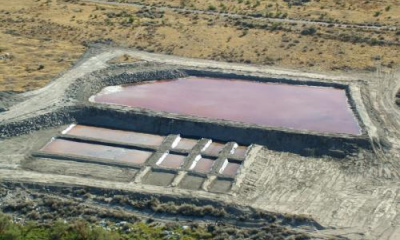The already beleaguered lake likely can’t endure the amount of extraction the company wants, expert says, despite claims the process will be “sustainable.”
Compass Minerals has made several splashy announcements in the last year about its lithium operations on the Great Salt Lake, including two “binding” contracts to supply a staggering amount of the material.
But state regulators have yet to sign off on the company’s extraction process, or ensure it won’t have negative impacts on the lake’s imperiled water supply and ecology.
“The simple answer is no, there’s no royalty agreement or any agreement that allows them to produce lithium at this point,” said Ben Stireman, deputy director of Lands and Minerals for the Division of Forestry, Fire and State Lands (FFSL), the agency that manages mining leases on the Great Salt Lake.
That didn’t stop Compass Minerals from issuing investor news releases implying the Great Salt Lake holds a lithium bonanza. Or forging “binding, multiyear” agreements to supply Ford Motor Company and LG Energy Solution with battery-grade material from its plant located near Ogden. Or claiming it will produce more of the stuff in a few years than the nation’s oldest and only operational lithium mine.
The declarations came to the alarm of policymakers, who put safeguards in place earlier this year to ensure new operations on the over-tapped lake don’t cause it any harm. And resource managers have expressed concern about the volume of water Kansas-based Compass implies it might need for its lithium process.
“It’s a pilot plan,” said Darren Hess, assistant general manager with Weber Basin Water Conservancy District. “They don’t know if this is really going to work out or not.”
The company has paid penalties for misleading investors about its work at other sites. Last year, the U.S. Securities and Exchange Commission hit Compass with a $12 million fine for claiming it would reduce costs at a mine in Canada, when it actually increased them, and for intentionally misreporting the extent of its mercury pollution at a facility in Brazil.
A spokesperson for Compass declined to comment on the record for this story.
Great Salt Lake could power a greener future, but at what cost?
As the nation amps up its efforts to electrify our grid and transportation systems in order to combat climate change, there’s an insatiable appetite for lithium. The element is used in batteries that are light, strong and long-lasting, but until recently, the U.S. only had one viable operation that could harvest the material.
Briny waters across the world, however, have loads of lithium that are more environmentally sound to extract than traditional hard-rock mining operations.
Lithium is also immensely more valuable than the potash fertilizer Compass has historically produced from the Great Salt Lake — $37,000 versus $1,700 per metric ton last year, according to the U.S. Geological Survey.
Mineral extractors like Compass and US Magnesium have eagerly eyed lithium’s potential in recent years, even as the lake recedes to record-low, devastating levels and blows a massive amount of lakebed dust pollution on some of Utah’s biggest cities. With that in mind, the Legislature approved rules last session to ensure sustainable mining on the lake.
“As the lake ... continues to disappear,” Rep. Casey Snider, R-Paradise, said at a committee hearing in February, “it becomes necessary for us to contemplate scenarios at the bottom of its elevation we never had to before,” including what to do about mineral extraction.
Snider passed a bill, HB513, requiring companies that harvest new materials like lithium to use the best available technology and minimize their water use, then provide water back to the Great Salt Lake to make up for any depletions. It also creates a salinity trigger that could force companies to stop diverting water from the lake if its elevation sinks too low.
It further requires resource managers to come up with royalties and taxes to adequately compensate the state for lithium and other rare-earth minerals pulled from the lake, a state-owned resource. They must also ensure any new material extraction doesn’t impact the lake’s chemistry or its unique but fragile ecosystem.
Compass announced its lithium-grade battery agreement with Ford in May, however, without any of those regulations or reviews ready to go.
“There’s nothing in [place] for an operator to extract lithium off the lake right now,” FFSL director Jamie Barnes told the Legislative Water Development Commission Monday after fielding concerns over the deal. “Nobody has a royalty agreement.”
(US Magnesium has temporary approval to produce lithium from its existing waste piles, but not directly from the lake’s brine).
Barnes said Compass’s premature announcement made it a “struggle” for her division to complete the required lithium policies and protect the lake.
“All of this is subject to an environmental standard that does not [yet] exist,” Snider said at the hearing, adding Compass likely extracted lithium to prove its method worked, also without the state’s permission. “What do we have to address that, if it occurred outside of statute?”
Barnes said her division is working with legal counsel to determine how to proceed.
Scott Paxman, a commission member and general manager of Weber Basin Water Conservancy District, noted Compass’s lithium plans require a “significant” quantity of both lake brine and treated water.
“We’re struggling with the concept of furnishing that much water,” Paxman said, “to one new industry that takes water away from the population.”
Mineral companies deplete 163,000 acre-feet from the lake each year, according to a recent Great Salt Lake Strike Team report, about enough water to support 300,000 homes. That’s around 10 times the amount of households in Ogden.
Of the extractors operating on the lake, Compass Minerals uses the most. It tapped 139,000 acre-feet in 2021, although that volume dropped to 74,000 last year, when the lake hit its lowest recorded elevation to date. About 7,700 acre-feet of treated and raw river water came from the Weber Basin water district’s deliveries, but the vast majority came from water rights Compass owns to pump directly from the Great Salt Lake.
The company requested an additional 1,200 gallons per minute of Weber Basin’s treated water to meet the demands of its new lithium plant, according to the district. That’s more than one-quarter of the water the district can supply to the entire west side of Weber County. Compass later walked back its request to 600 gallons per minute, but that would still double the amount of treated water it’s currently using.
“I’m not sure, exactly, why they need that much drinking-quality water,” Hess said.
‘I don’t know if it can sustain that much extraction’
Compass might need more fresh water to flush its processing equipment of corrosive brine, said Brendan Moran, a postdoctoral research associate at the University of Massachusetts Amherst who studies lithium mining from salty surface water and groundwater in arid environments. Or it might use it to clean membranes for a popular new reverse osmosis extraction method.
“It’s a continual use of fresh water,” Moran said. “And it’s one of the major concerns about that technology.”
The researcher expressed surprise at the load of lithium Compass claims it will produce from the Great Salt Lake — 11,000 metric tons annually by 2023, and 35,000 metric tons by the time it’s “fully operational,” according to investor news releases.
Nevada’s Silver Peak lithium mine, which has produced the mineral since the 1960s, only churns out 5,000 metric tons per year in contrast.
“And it’s a pretty big operation,” Moran said. “They’re trying to double it to 10,000, but ... it’s taking more time than they thought.”
He also wondered what Compass plans to do with new waste streams from the lithium process.
“I wouldn’t say it’s toxic in the sense of mercury or something,” Moran said, “but it’s not something you want to just dump into the lake.”
It raises questions about whether the company intends to mine lithium by pumping more brine into its evaporation ponds, or whether it will pull it from the existing Great Slat Lake water used to mine potash, Moran said.
“A shallow lake like this,” Moran said, “I don’t know if it can sustain that much extraction.”
Compass calls its lithium process a “sustainable development” that will use “the same unit of brine.”
SEC investigations show the company hasn’t always gotten the facts right. It runs the world’s largest underground salt mine near Ontario, Canada, and repeatedly told investors a 2017 technology upgrade would reduce costs, according to the SEC. The SEC found costs instead increased by 42%. Compass also exaggerated the volume of salt the mine produced, saying it could crank out 7.5 million tons a year when, in reality, it only scraped up 1.2 million tons.
Another probe found Compass cherry-picked test results it provided to environmental regulators at a plant it owned in Brazil, in order to downplay the amount of mercury getting discharged into the Botafogo River. It then failed to adequately assess the risk to investors of possible facility closure or sanctions from Brazilian authorities, the SEC found.
Moran says the promises for the Great Salt Lake project look hard to meet.
“The projections,” Moran said, “... I don’t think it’s feasible, from my perspective.”






